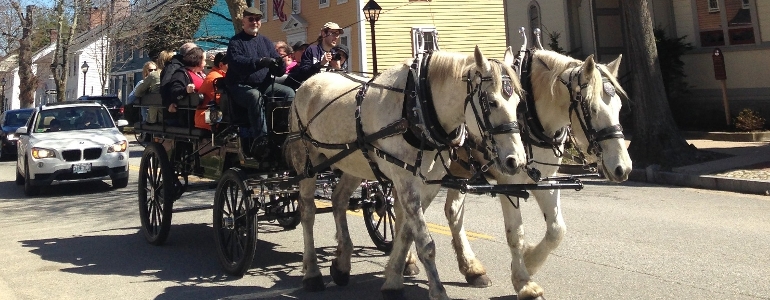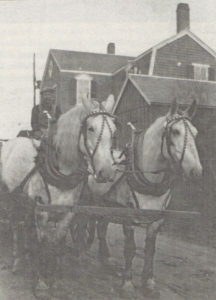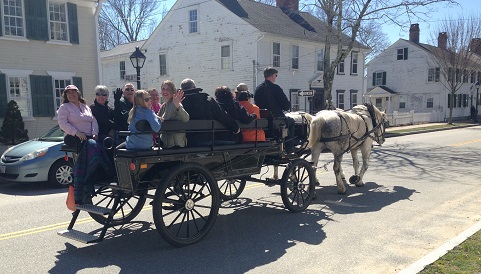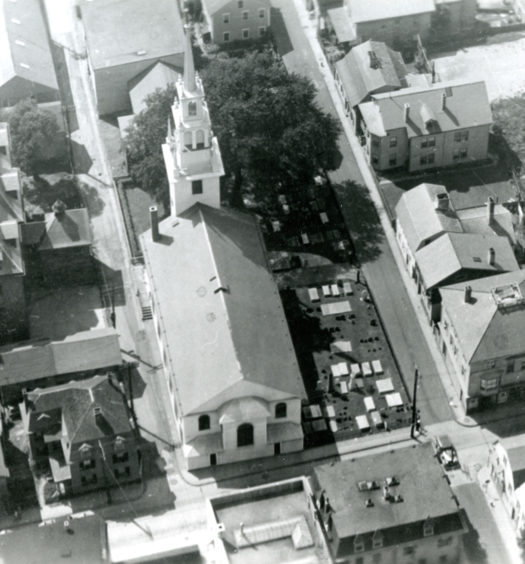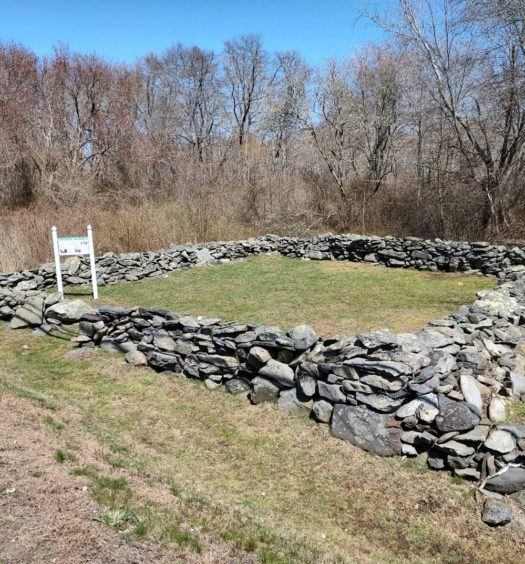A new twist on an old idea has arrived in the small seaport village of Wickford, Rhode Island. Amid the frenzy of fast-paced, always-connected life, visitors to this quaint tourist town might spot a team of draft horses pulling a wagonette along the main drag known as Brown Street, then disappearing around the corner onto Main Street and into the residential part of the village. Is this a rejection of fossil fuels and a nod toward a greener transportation method? Perhaps, but mostly it’s a way to couple the rich historical narrative of Wickford with a mode of travel that predates the invention of the high-speed lane.
The participants in this old–new partnership consist of an expert local historian and the owners of a horse-drawn carriage company from Saunderstown, a village just down the road from Wickford. Both parties have been active champions of the area. Tim Cranston’s prolific knowledge of the history of North Kingstown in general, and Wickford Village in particular, provides the background. New Deal Horse and Carriage has placed horses on the streets of the Village for many years, providing equine entertainment in the form of hayrides during annual Christmas celebrations and other events.
Transportation in Wickford—Boats, Trains, Automobiles . . . and Horses?
What is it about Wickford that lends itself to an obsolete method of conveyance? To answer this question, a short survey of Wickford’s transportation history is in order. As will be seen, changes in modes of transportation periodically transformed Wickford over the centuries.
Boats
The village of Wickford was originally the vision of Lodowick Updike, grandson of Richard Smith (of Smith’s Castle fame), one of North Kingstown’s first settlers. Starting at about 1709, the village grew slowly at first, with as many as twenty homes constructed by the time of the American Revolution, many of which still exist. It was during this period that Wickford became a maritime center, replete with an active shipbuilding trade that churned out hundreds of sailing vessels, from small dories and catboats right up to substantial schooners and ships at four separate shipyards. Many of the fine homes that lined Main Street and the Grand Highway (now Pleasant/Bay streets and Main/West Main streets) were constructed by local builders for various ship captains, owners, bankers, and merchants, all who benefited from Wickford’s prominence as a colonial trading center. After the war, development in Wickford, as in the rest of the region, was slow, but by the 1790s a resurgence of the coastal and West Indies trade, and a rapid expansion of fishing in the region, fueled a period of growth as a port and shipbuilding center.
In the 1830s, a one-two punch to Wickford’s shipbuilding industry precipitated a slow decline. The first blow came when the village was bypassed by the Providence and Stonington Railroad. The second strike took the form of a shipping war with Providence, brought about by high wharfage prices set by overly ambitious waterfront property owners. This dissuaded major shipping traders such as Brown & Ives from utilizing Wickford.
Trains
The village’s decline continued into the 1870s, when salvation ironically arrived in the form of another rail system, the Newport & Wickford Railway & Steamship Line. Funded largely by wealthy Newport patrons, including Cornelius Vanderbilt, tracks were laid as a way for these wealthy New Yorkers to avoid the long trek up through Providence and Bristol to get to their summer mansions in the City by the Sea. Trains left Wickford Junction (a rail stop several miles west of Wickford Village) on a regular schedule that tended to mirror that of the main line. Passengers and freight then made the short rail run down to Wickford, where a waiting steamer departed directly to Jamestown and Newport.
Revitalization via railcar continued with the construction of the Sea View Trolley Line some two decades later. It was funded largely by wealthy Narragansett casino owners and businessmen intent on providing an easy way to bring Rhode Islanders to their resorts and beaches. This electric trolley became an incredible boon to local residents, as it provided an inexpensive and convenient transportation option into Rhode Island’s more metropolitan northern communities such as Providence and Pawtucket. The Sea View also ran a daily “farmer’s run” through the rural areas, picking up dairy and agricultural products for ultimate delivery to the large produce markets in Providence. The Sea View trolley company also developed an extensive coal transportation business. And as yet another fringe benefit, excess power from the trolley distribution system was sold to homes and businesses adjacent to the tracks, bringing electric power into North Kingstown homes for the first time.
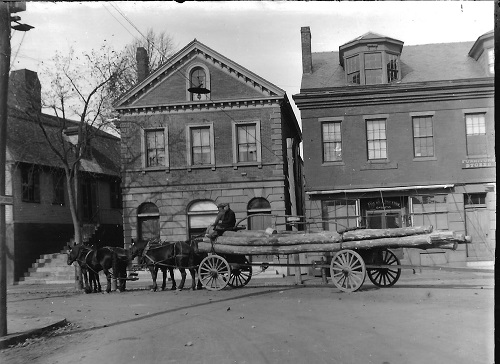
Hauling lumber on Main Street, Wickford, circa 1900 (North Kingstown Free Library, South County Collection)
Automobiles
Once again, it was a transportation-related change that brought this period in Wickford’s history to an abrupt close. As “a car in every driveway” became the norm, fewer people utilized the Sea View Trolley Line and the Newport & Wickford Line, and both ventures were shuttered. A most ironic event occurred in 1922, when Henry Ford himself, while in the area, purchased one of the steam engines used by the Sea View for display in his museum village in Dearborn, Michigan. As America went car-crazy, so did Wickford, and as the twentieth century continued, the adoption of the interstate highway and suburban sprawl loomed large, threatening the Village’s trove of intact colonial and early nineteenth century homes.
Back to the Future
Even as the cars rolled in, Wickford managed to resist the force of demolition and development. Pressure mounted as World War II arrived. The rapidly paced construction of the military complex at nearby Quonset/Davisville caused an influx of residents, first for construction and then for base staffing purposes, which overwhelmed the local housing stock and forced the modification of many of the village’s larger homes into smaller apartments. Dredging associated with base construction also fatally wounded one of the village’s most prominent industries, oyster farming, which at its peak employed more than one hundred locals. This activity effectively ended large-scale fishing and aquaculture as a major employer in Wickford Harbor and the surrounding areas.
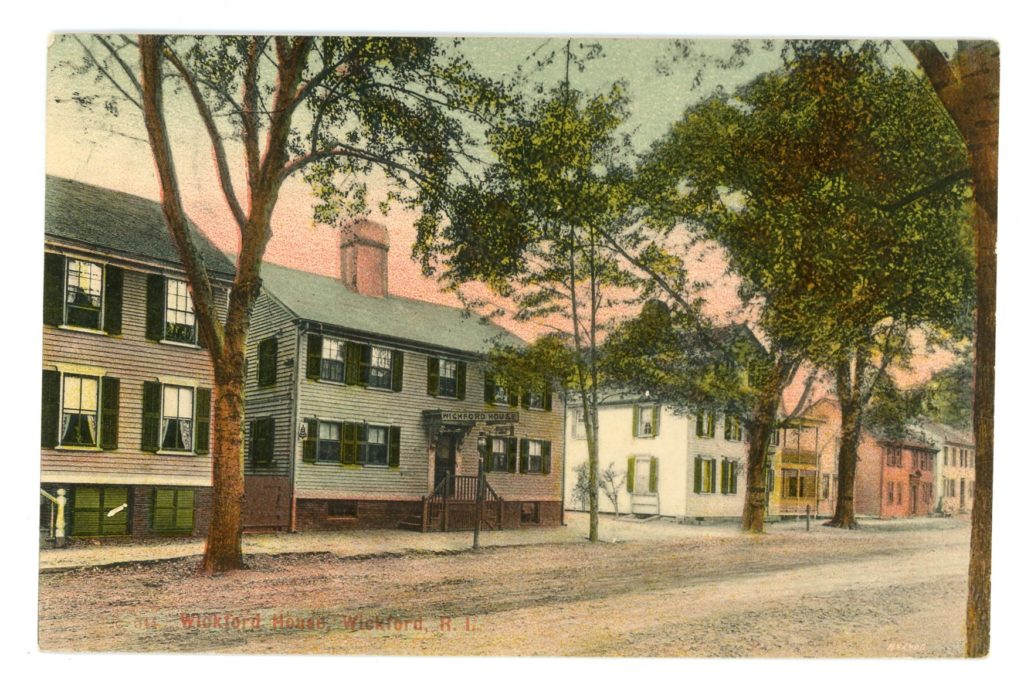
Many of Wickford’s historic houses look the same today as they did in the above turn-of-the-century postcard (Sanford Neuschatz Collection).
To our benefit, out of all this upheaval and distress came the impetus that forever preserved the village in the beautiful condition we see it today. Local residents had already banded together into a group called the Main Street Association, whose original charge and charter was solely to save the rapidly dying American Elms that gracefully lined all the village streets. Presciently seeing the threats to historic homes, the group changed its focus in reaction to developmental pressures on the village’s ancient housing stock. As a result of its foresight, Wickford has survived into the twenty-first century largely intact as a result of the groundbreaking use of comprehensive historic zoning in the 1930s. In retrospect, an effort that began with a passion to save the village’s signature trees ended up preserving the entire village itself.
Fitting Horses into the Story
It can be argued that horses are as much a part of our transportation history as any method that charted Wickford’s legacy. Certainly, horses helped early settlers clear land and move materials. Cities and towns large and small, not only Wickford, owe their existence to horse power. Their role as a means of conveyance, though, is just as important. A horse-drawn omnibus with regularly scheduled rides on a standard route was a precedent for present-day public transportation, yet is modern enough to be a recognizable to someone in the twenty-first century. But what must it have been like to have to harness a horse and hitch him to a vehicle as a prerequisite to go anywhere? The advance of increasingly faster modes of transportation has deprived us the experience of life in the slow lane, when going somewhere had to be planned and could not be rushed, when the pace of life was limited by the pace of horses. The experience of traveling by horse-drawn carriage is lost in a modern world. Thus, the creation of an historical horse-drawn tour in Wickford Village, aptly named “Traveling in the Past,” harkens back to a time when a person’s town was his world.
The inaugural run of “Traveling in the Past” in Wickford is scheduled for April 29 and 30, 2017. For tickets to this and future tours, please visit https://www.newdealcarriage.com/wickford-carriage-rides.
Sources
Clay McShane and Joel Tarr, The Horse in the City (Baltimore, MD.: Johns Hopkins University Press, 2009).
The author borrowed liberally (and with permission) from Timothy G. Cranston, Walking in Olde Wickford: The History of Old Wickford, One House at a Time (CreateSpace, 2011), pp. 9–13.
The author would like to thank Tom Frawley, Reference and Non-Fiction Services Coordinator at the North Kingstown Free Library, for his assistance with the South County Collection.

